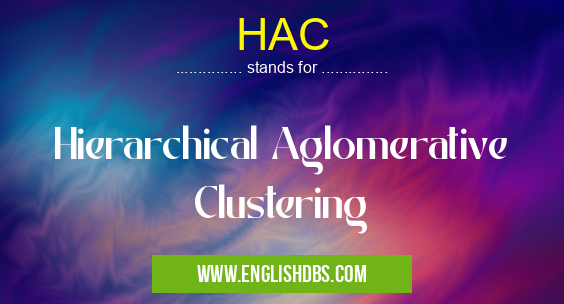What does HAC mean in UNCLASSIFIED
HAC (Hierarchical Aglomerative Clustering) is a widely used clustering algorithm in data analysis and machine learning. It aims to construct a hierarchical tree-like structure, known as a dendrogram, that represents the relationships and similarities among a set of data points.

HAC meaning in Unclassified in Miscellaneous
HAC mostly used in an acronym Unclassified in Category Miscellaneous that means Hierarchical Aglomerative Clustering
Shorthand: HAC,
Full Form: Hierarchical Aglomerative Clustering
For more information of "Hierarchical Aglomerative Clustering", see the section below.
How HAC Works
HAC starts by considering each data point as an individual cluster. It then iteratively merges the two closest clusters until all data points are in a single cluster. The distance between clusters is typically computed using a metric such as Euclidean distance or cosine similarity.
The merging process proceeds as follows:
- Calculate the distance matrix between all pairs of clusters.
- Find the two closest clusters.
- Merge these clusters into a single new cluster.
- Update the distance matrix to reflect the new cluster structure.
Types of HAC Algorithms
There are several variations of HAC algorithms, each using a different linkage criterion to determine the distance between clusters. The most common linkage criteria include:
- Single Linkage (Nearest Neighbor): Merges clusters based on the distance between their closest data points.
- Complete Linkage (Farthest Neighbor): Merges clusters based on the distance between their farthest data points.
- Average Linkage (UPGMA): Merges clusters based on the average distance between all pairs of data points in the clusters.
- Weighted Average Linkage (WPGMA): Similar to Average Linkage, but weights the distance based on the number of data points in each cluster.
Advantages and Disadvantages of HAC
Advantages:
- Intuitive and easy to understand.
- Produces a hierarchical representation of data relationships.
- Can handle large datasets efficiently.
Disadvantages:
- Can be sensitive to outliers and noisy data.
- The choice of linkage criterion can significantly impact the clustering results.
- Can be computationally expensive for very large datasets.
Essential Questions and Answers on Hierarchical Aglomerative Clustering in "MISCELLANEOUS»UNFILED"
What is Hierarchical Aglomerative Clustering (HAC)?
HAC is an iterative clustering algorithm that constructs a hierarchy of clusters, starting with each data point as its own cluster and iteratively merging the most similar clusters until a single cluster is formed.
How does HAC work?
HAC uses a bottom-up approach, initially treating each data point as a separate cluster. It calculates the distance or similarity between all pairs of clusters and merges the two most similar clusters into a single cluster. This process continues until all data points are merged into a single cluster.
What are the different linkage methods in HAC?
HAC uses various linkage methods to determine the similarity between clusters. Some common methods include:
- Single linkage: Considers the distance between the closest pair of points in the clusters.
- Complete linkage: Considers the distance between the farthest pair of points in the clusters.
- Average linkage: Calculates the average distance between all pairs of points in the clusters.
- Ward's method: Minimizes the increase in within-cluster variance when merging clusters.
What are the advantages of using HAC?
HAC offers several advantages, including:
- Hierarchical representation: Provides a complete view of the clustering process and allows for different levels of clustering to be explored.
- Flexibility: Supports various linkage methods and distance metrics, allowing for customization based on the data and application.
- Robustness: Can handle noise and outliers in the data.
What are the disadvantages of using HAC?
HAC also has some limitations:
- Computational complexity: The time complexity of HAC can be high, especially for large datasets.
- Sensitivity to linkage method: The choice of linkage method can significantly impact the clustering results.
- Lack of optimality: HAC does not guarantee finding the optimal clustering solution, as it relies on a greedy approach.
Final Words: HAC is a powerful clustering algorithm that has been widely used in various domains, including data mining, pattern recognition, and bioinformatics. By constructing a hierarchical structure, HAC provides valuable insights into the relationships and similarities among data points. However, it is important to note its limitations and choose the appropriate linkage criterion for the specific application.
HAC also stands for: |
|
| All stands for HAC |
